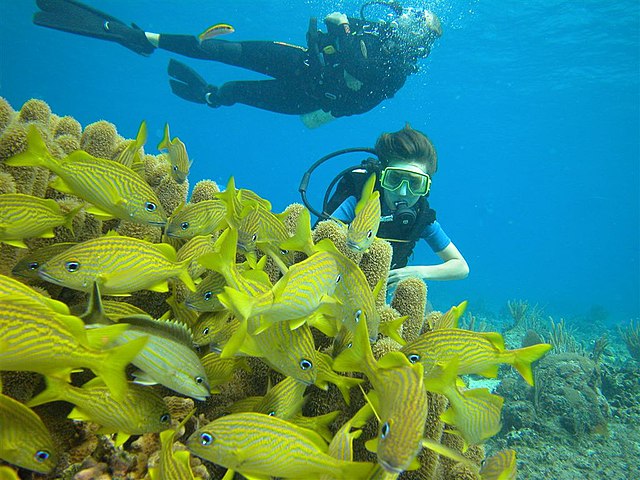underwater diving where the diver breathes from apparatus (scuba) which is completely independent of surface supply From Wikipedia, the free encyclopedia
Scuba diving is an activity where people (called "scuba divers", or simply "divers") can swim underwater. They can be underwater a long time by having a tank filled with compressed air. The tank is a large metal cylinder made of steel or aluminum.

The word scuba is an acronym from "Self-Contained Underwater Breathing Apparatus".

In the 1600s, a diving bell would be lowered that had trapped air in it. A diving bell is like a large heavy upside-down bucket that holds air inside when lowered into the water. A diver would breathe that air and swim in an and out of the bell to work until the air became bad. Later fresh air was pumped to the diving bell through a hose, so the diver could stay longer.
The first diving suits used a heavy copper diving helmet with windows and a hose from an air pump. The helmet was clamped to a waterproof diving suit. Divers would wear heavy weights and walk on the seafloor as it was not safe to swim.[1] The air hose would send air to the helmet from a pump on land or on a boat above the diver. The air would pass through the helmet and out into the water through a valve, and the diver would breathe from the air in the helmet. This wasted a lot of air, but there was no way to only supply air when the diver needed it. This is called a free-flow system.
Jacques Cousteau was a Frenchman who developed several important parts of the scuba system and made it useful. One part was a better regulator that only sent air when the diver breathed in. This let the divers go farther on one tank. It was made with a mouthpiece on a rubber hose, so a heavy helmet was not needed. It was light enough to use with fins and easily swim. He also took many underwater movies and showed people what was under the water and why it needed to be protected.[2]
There have been improvements to scuba equipment since Cousteau to make it safer and easier to use.
Divers face dangers that can hurt or kill them if they don't know what to do. They can use up all their air, or get decompression sickness or nitrogen narcosis. A person must be trained to use the equipment and dive safely. When they show that they can dive safely they get a certification card. The biggest organization for certifying divers is PADI - Professional Association of Diving Instructors - but there are many others, depending on the country. Some tourist places have a short course without certification and then the instructor will lead the diver in a shallow dive, all in one day.
Because of special dangers, there are advanced classes for things like diving in or around underwater shipwrecks, cave diving, and deep diving (more than 60 feet or 18 meters).[3]
Seamless Wikipedia browsing. On steroids.
Every time you click a link to Wikipedia, Wiktionary or Wikiquote in your browser's search results, it will show the modern Wikiwand interface.
Wikiwand extension is a five stars, simple, with minimum permission required to keep your browsing private, safe and transparent.